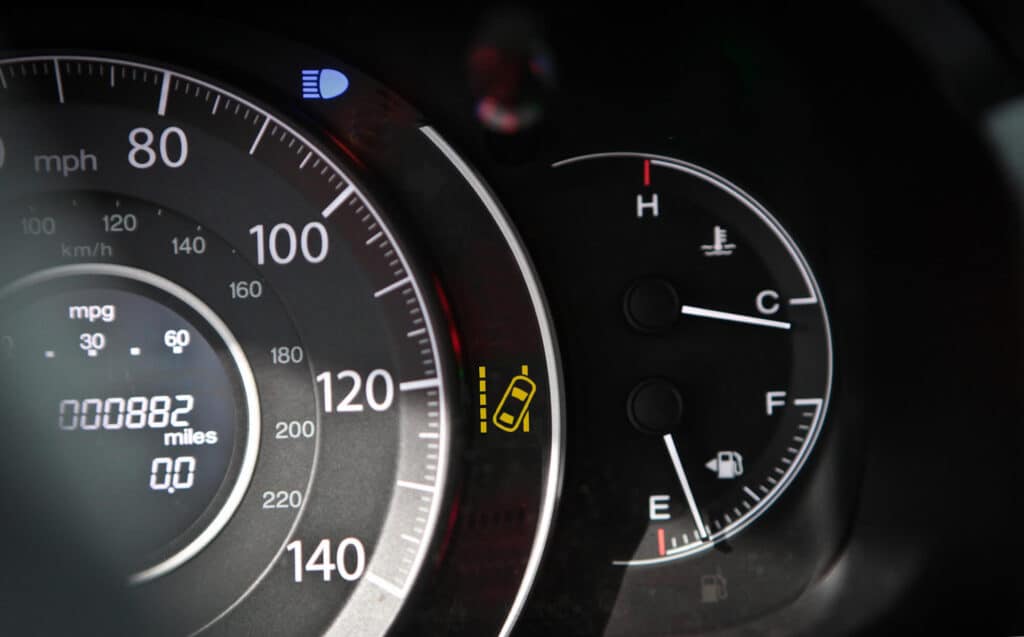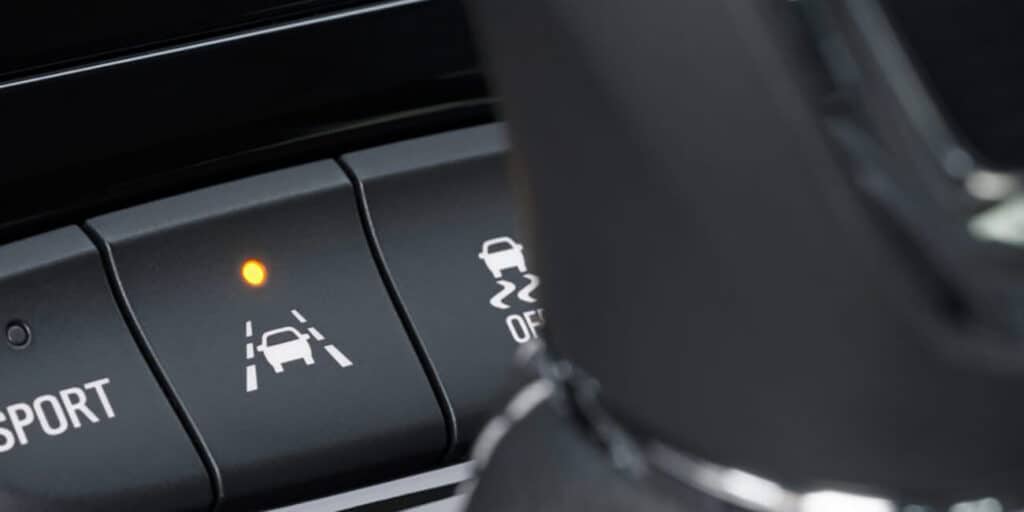Lane Departure Warning – The Unsung Hero of Highway Safety
Imagine driving down a scenic highway, with your favorite tunes blaring, only to be jolted out of your bliss by a sudden warning light on your dashboard. You’ve just met the unsung hero of highway safety: the Lane Departure Warning system. This modern marvel helps drivers stay in their lanes, reduces the risk of side-swipe collisions, and is fast becoming a staple feature in new cars. Simply put, it’s a technological guardian angel that can prevent tragedies before they happen.
Decoding the Light: What Does the Lane Departure Warning Light Mean?
Green Light: When you see a green light on your dashboard, take it as a green flag from your car. This means the Lane Departure Warning system is fully operational, actively monitoring your vehicle’s position within the lane. Simply put, you’re in good hands, and the system is ready to alert you should you drift from your lane.
Yellow or Red Light: These are the colors you need to pay attention to. A yellow or red light indicates that the system has detected an unintentional lane departure. Whether it’s an inadvertent nudge of the steering wheel or fatigue kicking in, these colors are your cue to readjust your driving. In other words, consider these as your car’s way of nudging you back to full attention and safer driving.

The Control Question: How to Turn Off or Adjust Lane Departure Warning
Lane Departure Warning systems offer a dynamic mix of safety and technology, designed to keep you on the straight and narrow—literally. However, not everyone is keen on letting their car play co-pilot. If you find the feature more annoying than assistive, you’ll be relieved to know that most systems offer the flexibility to disable or adjust it. Accessing this option can differ from one vehicle model to another, but you’ll generally find it in your car’s settings menu, under the ‘Driver Assistance’ or similar category. After navigating through a few sub-menus, you’ll likely discover the toggle switch to deactivate the feature.
But before you press that ‘off’ button, consider the implications. While it may seem like just another alert buzzing or flashing in your dashboard, the Lane Departure Warning system serves a significant safety function. Disabling it means you’re relinquishing an extra layer of protection that could potentially save lives—yours included. It’s always a good idea to weigh the pros and cons and possibly even consult your vehicle’s manual to fully understand what you’re choosing to give up.
For those not looking to completely shut off the feature but rather tweak it to their liking, many modern systems offer customizable settings. You might find options to change the type of warning—be it visual, auditory, or haptic (vibration)—or even adjust the sensitivity, ensuring the alerts are neither too frequent nor too late.
How It Works: The Technology Behind Lane Departure Warnings
If you’re curious about the brains behind the operation:
• Sensors Galore: At the heart of the Lane Departure Warning system are a series of advanced cameras and sensors. These are strategically placed—often at the front of the vehicle—to scan and monitor the road ahead for lane markings.
• Software Sophistication: These sensors are only as good as the software interpreting the data. Advanced algorithms analyze the feed in real-time, determining if the vehicle is staying within its lane or starting to drift.
• Comparison with Blind-Spot Systems: While it may sound similar to blind-spot warning systems, the Lane Departure Warning system serves a unique purpose. It specifically focuses on lane markings rather than detecting other vehicles in your blind spots. Each system uses different algorithms and may even use different types of sensors.
• Lane Assist vs. Lane Departure: Don’t confuse Lane Departure Warning with Lane Assist—though they’re cousins, they’re not identical twins. Lane Assist goes a step further by not just warning you but also taking control of the steering wheel to gently guide your car back into its lane.
• Intelligent Alerts: Depending on the sophistication of your car’s system, you may receive different types of alerts. These can range from visual cues on the dashboard to auditory beeps or even tactile feedback like steering wheel vibrations.
• Customization: Some systems allow drivers to adjust sensitivity settings, enabling you to tailor the technology to your comfort level. Whether you want softer warnings or more aggressive nudges, many systems offer a range of customization options.
• Real-Time Monitoring: The system operates in real-time, continuously analyzing data as you drive. This ensures immediate alerts and actions to prevent unintentional lane departures.
Effectiveness and Limitations: Night Time, Snow, and Other Scenarios
• Night-Time Driving: As much as we’d like to believe our car’s technology is invincible, the effectiveness of the Lane Departure Warning system tends to dip at night. Reduced visibility can make it challenging for the system’s sensors to detect lane markings, thereby affecting its reliability.
• Snow and Adverse Weather: Snow-covered or wet roads can throw off the system’s accuracy. The sensors might find it difficult to differentiate between the road and the lane markings, making the system less reliable in these conditions.
• Human Instinct Over Tech: While the system is remarkably effective in clear conditions, it’s essential to know when to override it. For instance, when navigating through a storm or when the road is chaotic due to construction, your own driving instincts and manual control should take precedence.
• False Positives and Negatives: Be aware that no system is foolproof. In certain conditions, the system might either fail to detect a lane departure (false negative) or alert you when you’re actually within your lane (false positive). Always maintain full attention while driving to complement the tech’s capabilities.
Know the Cost: Potential Repairs Related to the Warning Light and Cost Breakdown
When it comes to the Lane Departure Warning system, a persistent warning light isn’t something to sweep under the rug. This could be your car’s way of flagging down a variety of issues. At the simpler end of the spectrum, it might be that the system’s sensors are dirty or obstructed. A quick cleaning could cost you as little as $50 and make all the difference. In other cases, the system might be picking up on alignment problems or issues with the onboard computer. Here, costs can start to climb, easily reaching between $200 and $500, depending on the vehicle make and model.
And let’s not forget the more severe scenarios where the entire system may need to be replaced. While this is rare, it’s a possibility, and the costs could escalate to well over $500. Given the wide cost range, it’s crucial to consult a qualified mechanic who can perform a comprehensive diagnostic. This will not only pin down the issue but also give you an accurate estimate of the impending repair costs. Ignoring the warning could result in safety risks and even higher repair bills down the line, so take it seriously.

To Use or Not to Use: When Lane Assist is Counterproductive
The Lane Assist system is often heralded as a road safety marvel, but it’s not foolproof. There are circumstances where activating this system might do more harm than good. Imagine driving through a fierce snowstorm, where the lane markings are obscured. In such conditions, the system’s sensors can get confused, and its guidance can become unreliable. The same goes for driving on roads that are under construction or have uneven pavement. Here, the system might misinterpret the temporary or inconsistent lane markings and guide you erroneously.
Similarly, if you’re navigating tight corners or narrow roads, the system might not respond well to the rapid changes in steering input. During such times, it’s advisable to take manual control and disable the Lane Assist system temporarily. The key takeaway here is that while Lane Assist and Lane Departure Warning systems are exceptional tools for enhancing road safety, they are not a substitute for human judgment. It’s crucial to understand when to rely on the tech and when to go old-school with your driving skills.
Conclusion: Navigating the Nuances of Lane Departure Warning Systems
Understanding the complexities and limitations of Lane Departure Warning systems empowers you to make the most of this incredible safety feature. Remember, technology is only as good as how effectively you use it.
For those uncertain moments when a dashboard light leaves you puzzled, or if you need professional service related to these advanced systems, consider Uchanics for reliable mobile mechanic services in Canada. Knowledgeable, efficient, and just a call away—because sometimes, your car’s guardian angel needs a little backup.
